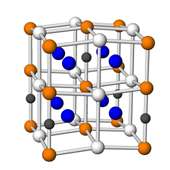March 22, 2010 report
Iron-nitrogen compound forms strongest magnet known

(PhysOrg.com) -- A group of scientists from the University of Minnesota say that Fe16N2 crystals are more magnetic than the most magnetic material previously known, and its magnetism exceeds the predicted limit of magnetism for a material.
Magnetism arises with the spinning electrons in a material, and with every electron acting as a tiny magnet with its magnetic field aligned with the axis of spin. In most atoms electrons may spin either ‘up’ or ‘down’, but when most of them spin in the same direction, the material becomes magnetic. In iron, for example, there are four more spinning in one direction than in the other.
In a more complex material, the theory is that there are river-like bands of electron clouds formed as those of the individual atoms merge together. Each band contains electrons spinning in only one direction, and the material’s magnetism is determined by the difference between the numbers of each type of band. Using the theory, scientists have predicted that iron-cobalt should be the most magnetic material.
A group of materials physicists from Twin Cities, Minnesota, led by Jian-Ping Wang have found a material comprising 16 iron atoms and two of nitrogen is approximately 18% more magnetic than the predicted limit. The findings of x-ray analysis of the compound showed that six iron atoms are clustered around each nitrogen, with two more located between the two clusters. The researchers said electrons flowing between the clusters act like they do in ordinary iron, but within the clusters, the electrons tend to be localized, and this increases the magnetism.
Wang said it was suggested in 1972 that Fe16N2 was extremely magnetic, and this was backed up by Hitachi researchers in the 1990s, but these findings were not confirmed by later researchers. Fe16N2 is metastable and tends to form other crystal structures, complicating estimations of the volume of the material that is actually Fe16N2. Unlike previous studies, the present research used x-ray magnetic circular dichroism to measure the magnetization. This technique directly detects the localized electrons, and is thus less sensitive to volume effects than the earlier methods. Wang and the team have also produced simulations showing how the localized electrons emerge, which Wang says “make the whole scenario hang together”.
If the magnets can be manufactured commercially they could allow computer manufacturers to use smaller write heads that could hold more information. The findings were reported at the American Physical Society’s meeting this month.
More information: adsabs.harvard.edu/abs/2010APS..MART33003W
© 2010 PhysOrg.com


















